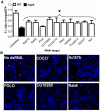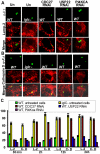Host factors required for modulation of phagosome biogenesis and proliferation of Francisella tularensis within the cytosol
- PMID: 20552012
- PMCID: PMC2883998
- DOI: 10.1371/journal.pone.0011025
Host factors required for modulation of phagosome biogenesis and proliferation of Francisella tularensis within the cytosol
Abstract
Francisella tularensis is a highly infectious facultative intracellular bacterium that can be transmitted between mammals by arthropod vectors. Similar to many other intracellular bacteria that replicate within the cytosol, such as Listeria, Shigella, Burkholderia, and Rickettsia, the virulence of F. tularensis depends on its ability to modulate biogenesis of its phagosome and to escape into the host cell cytosol where it proliferates. Recent studies have identified the F. tularensis genes required for modulation of phagosome biogenesis and escape into the host cell cytosol within human and arthropod-derived cells. However, the arthropod and mammalian host factors required for intracellular proliferation of F. tularensis are not known. We have utilized a forward genetic approach employing genome-wide RNAi screen in Drosophila melanogaster-derived cells. Screening a library of approximately 21,300 RNAi, we have identified at least 186 host factors required for intracellular bacterial proliferation. We silenced twelve mammalian homologues by RNAi in HEK293T cells and identified three conserved factors, the PI4 kinase PI4KCA, the ubiquitin hydrolase USP22, and the ubiquitin ligase CDC27, which are also required for replication in human cells. The PI4KCA and USP22 mammalian factors are not required for modulation of phagosome biogenesis or phagosomal escape but are required for proliferation within the cytosol. In contrast, the CDC27 ubiquitin ligase is required for evading lysosomal fusion and for phagosomal escape into the cytosol. Although F. tularensis interacts with the autophagy pathway during late stages of proliferation in mouse macrophages, this does not occur in human cells. Our data suggest that F. tularensis utilizes host ubiquitin turnover in distinct mechanisms during the phagosomal and cytosolic phases and phosphoinositide metabolism is essential for cytosolic proliferation of F. tularensis. Our data will facilitate deciphering molecular ecology, patho-adaptation of F. tularensis to the arthropod vector and its role in bacterial ecology and patho-evolution to infect mammals.
Conflict of interest statement
Figures






Similar articles
-
Molecular complexity orchestrates modulation of phagosome biogenesis and escape to the cytosol of macrophages by Francisella tularensis.Environ Microbiol. 2010 Sep;12(9):2559-86. doi: 10.1111/j.1462-2920.2010.02229.x. Epub 2010 May 7. Environ Microbiol. 2010. PMID: 20482590 Free PMC article.
-
Molecular bases of proliferation of Francisella tularensis in arthropod vectors.Environ Microbiol. 2010 Sep;12(9):2587-612. doi: 10.1111/j.1462-2920.2010.02230.x. Epub 2010 May 7. Environ Microbiol. 2010. PMID: 20482589 Free PMC article.
-
Intracellular fate of Francisella tularensis within arthropod-derived cells.Environ Microbiol. 2009 Jun;11(6):1473-81. doi: 10.1111/j.1462-2920.2009.01875.x. Epub 2009 Feb 10. Environ Microbiol. 2009. PMID: 19220402
-
Cell biology and molecular ecology of Francisella tularensis.Cell Microbiol. 2010 Feb;12(2):129-39. doi: 10.1111/j.1462-5822.2009.01400.x. Epub 2009 Oct 27. Cell Microbiol. 2010. PMID: 19863554 Review.
-
Francisella tularensis travels a novel, twisted road within macrophages.Trends Microbiol. 2006 Jan;14(1):37-44. doi: 10.1016/j.tim.2005.11.008. Epub 2005 Dec 13. Trends Microbiol. 2006. PMID: 16356719 Review.
Cited by
-
Tularemia progression accompanied with oxidative stress and antioxidant alteration in spleen and liver of BALB/c mice.J Microbiol. 2012 Jun;50(3):401-8. doi: 10.1007/s12275-012-1621-8. Epub 2012 Jun 30. J Microbiol. 2012. PMID: 22752903
-
Francisella-arthropod vector interaction and its role in patho-adaptation to infect mammals.Front Microbiol. 2011 Feb 18;2:34. doi: 10.3389/fmicb.2011.00034. eCollection 2011. Front Microbiol. 2011. PMID: 21687425 Free PMC article.
-
The francisella intracellular life cycle: toward molecular mechanisms of intracellular survival and proliferation.Front Microbiol. 2010 Dec 28;1:138. doi: 10.3389/fmicb.2010.00138. eCollection 2010. Front Microbiol. 2010. PMID: 21687806 Free PMC article.
-
Reliance of Wolbachia on High Rates of Host Proteolysis Revealed by a Genome-Wide RNAi Screen of Drosophila Cells.Genetics. 2017 Apr;205(4):1473-1488. doi: 10.1534/genetics.116.198903. Epub 2017 Feb 3. Genetics. 2017. PMID: 28159754 Free PMC article.
-
Mechanisms of Francisella tularensis intracellular pathogenesis.Cold Spring Harb Perspect Med. 2013 Apr 1;3(4):a010314. doi: 10.1101/cshperspect.a010314. Cold Spring Harb Perspect Med. 2013. PMID: 23545572 Free PMC article. Review.
References
-
- Santic M, Akimana C, Asare R, Kouokam JC, Atay S, et al. Intracellular fate of Francisella tularensis within arthropod-derived cells. Environ Microbiol. 2009;11:1473–1481. - PubMed
-
- Titball R, Sjosted A. Francisella tularensis: an overview. ASM News. 2003;69:558–563.
Publication types
MeSH terms
Substances
Grants and funding
LinkOut - more resources
Full Text Sources
Molecular Biology Databases
Miscellaneous

